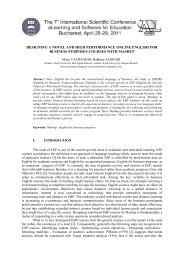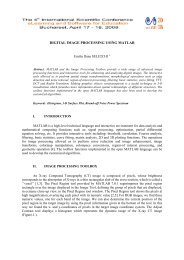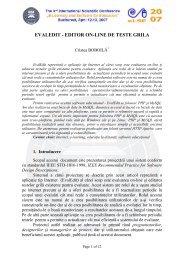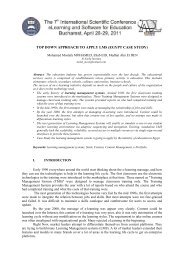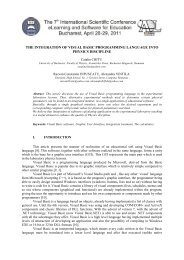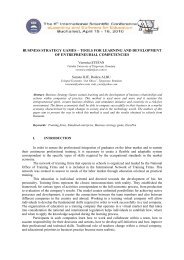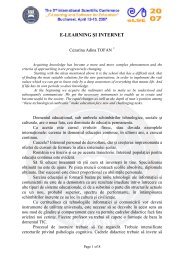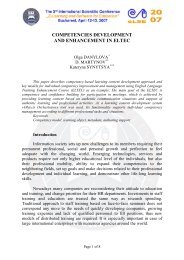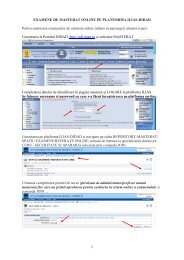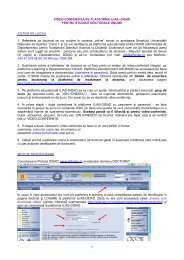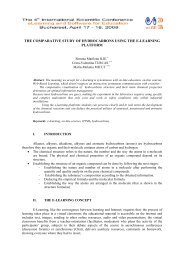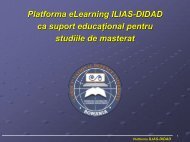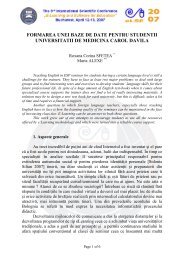it in foreign language teaching â comparing pedagogical options
it in foreign language teaching â comparing pedagogical options
it in foreign language teaching â comparing pedagogical options
Create successful ePaper yourself
Turn your PDF publications into a flip-book with our unique Google optimized e-Paper software.
especially w<strong>it</strong>h beg<strong>in</strong>ners, this may lead to mak<strong>in</strong>g them feel overwhelmed w<strong>it</strong>h<br />
<strong>in</strong>accessible lexis).<br />
III. ILLUSTRATION OF THE PROPOSED APPROACH AND OPEN<br />
CONCLUSIONS<br />
In the concrete educational context of the author, the learners’ profile covers a tra<strong>it</strong> that should<br />
be taken <strong>in</strong>to consideration when the <strong>foreign</strong> <strong>language</strong> teacher designs and uses IT <strong>in</strong> the <strong>language</strong><br />
class, viz. the fact that they are eng<strong>in</strong>eer<strong>in</strong>g students, possess<strong>in</strong>g (advanced) computer skills – <strong>in</strong> the<br />
case of Computer Science ones. This is a fact that is <strong>in</strong>fluential <strong>in</strong> determ<strong>in</strong><strong>in</strong>g the approach to<br />
teach<strong>in</strong>g us<strong>in</strong>g IT that the teacher has made.<br />
Together w<strong>it</strong>h their computer l<strong>it</strong>eracy level, other elements <strong>in</strong> the students’ profile to be<br />
considered are their level of <strong>language</strong> proficiency, the course of <strong>language</strong> type and ma<strong>in</strong> objectives, as<br />
well as the short- and mostly long-term needs of the learners.<br />
In general, we will make reference to ESP type of course that we teach <strong>in</strong> the Bucharest<br />
Polytechnic, discuss<strong>in</strong>g the concrete cases the author has been <strong>in</strong>volved lately <strong>in</strong>:<br />
- English for Professional Communication (EPC) practical courses to first and second<br />
year students, at B1/B2 level,<br />
- English for Science and Technology (EST) practical courses to second year students of<br />
the Computer Science Faculty, at B2/C1 level,<br />
- Scientific and Technical Communication <strong>in</strong> English (STCE) course and applications to<br />
Master of Science students, at B2/C1 level,<br />
- Technical Russian practical course to first year students of the Transports Faculty, at<br />
A1/A2 level.<br />
It is obvious that the type of course and the level dictate some <strong>options</strong> <strong>in</strong> terms of the IT<br />
support used, but the pr<strong>in</strong>ciples underly<strong>in</strong>g the <strong>options</strong> are more or less the same. It is used <strong>in</strong> order to<br />
create the k<strong>in</strong>d of activ<strong>it</strong>ies which should answer the specific needs of the students <strong>in</strong> terms of their<br />
learn<strong>in</strong>g process, which should have a clear purpose and be well <strong>in</strong>tegrated <strong>in</strong> the general course<br />
approach, <strong>in</strong> order to help the actors of the <strong>in</strong>struction process to be more successful <strong>in</strong> atta<strong>in</strong><strong>in</strong>g the<br />
established goals.<br />
The teach<strong>in</strong>g approach is of an eclectic type, w<strong>it</strong>h <strong>options</strong> that are, we hope, well justified<br />
from the <strong>pedagogical</strong> po<strong>in</strong>t of view. It is mostly of the communicative type, but other methods and<br />
means are accepted, if they can ensure success.<br />
In what follows, a selection of IT means used <strong>in</strong> each of these types of <strong>language</strong> courses is<br />
briefly presented, as an illustration of the po<strong>in</strong>ts made above. Thus, for the practical courses of the<br />
ESP type, which take place <strong>in</strong> the multimedia laboratory, we use <strong>in</strong> comb<strong>in</strong>ation the computer &<br />
videoprojector, the document camera and the students’ computers, which provides an array of<br />
possibil<strong>it</strong>ies of comb<strong>in</strong><strong>in</strong>g them, We use them at all the stages of the course, and for all the skills under<br />
focus. We frequently refer to onl<strong>in</strong>e dictionaries of the Worldweb type and make use of resources<br />
from the Internet or CDs.<br />
For the STCE course, we comb<strong>in</strong>e the course theoretical presentation on PowerPo<strong>in</strong>t slides,<br />
w<strong>it</strong>h provid<strong>in</strong>g the students w<strong>it</strong>h handouts, provid<strong>in</strong>g space for supplementary notes on the students’<br />
pages, while the applications are solved w<strong>it</strong>h the help of computers <strong>in</strong> the lab.<br />
As far as the course of Russian is concerned, due to the fact that we start from the A1 level,<br />
which means we teach the beg<strong>in</strong>ner level, we comb<strong>in</strong>e the use of the IT means w<strong>it</strong>h a more regular use<br />
of the board – for handwr<strong>it</strong><strong>in</strong>g tasks, especially dur<strong>in</strong>g the first part of the course, as there are marked<br />
differences between the hand wr<strong>it</strong>ten Russian alphabet and the pr<strong>in</strong>ted one, which the learners should<br />
be taught to make.<br />
It is of course not possible to illustrate <strong>in</strong> this section, not even briefly, the variety of<br />
comb<strong>in</strong>ations of IT means used at different stages of the courses <strong>in</strong> each case. It is the teacher who<br />
should take decisions <strong>in</strong> this respect, thus gradually develop<strong>in</strong>g the skill of select<strong>in</strong>g the most<br />
appropriate IT tool for each stage and objective of the lesson.



